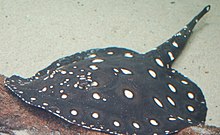| Xingu River ray | |
|---|---|

| |

| |
| Conservation status | |
 Vulnerable (IUCN 3.1) | |
| CITES Appendix II (CITES) | |
| Scientific classification | |
| Domain: | Eukaryota |
| Kingdom: | Animalia |
| Phylum: | Chordata |
| Class: | Chondrichthyes |
| Subclass: | Elasmobranchii |
| Order: | Myliobatiformes |
| Family: | Potamotrygonidae |
| Genus: | Potamotrygon |
| Species: | P. leopoldi |
| Binomial name | |
| Potamotrygon leopoldi Castex & Castello, 1970 | |
The Xingu River ray, River stingray, white-blotched river stingray, or polka-dot stingray (Potamotrygon leopoldi) is a species of freshwater fish in the family Potamotrygonidae. It is endemic to the Xingu River basin in Brazil and as such prefers clear waters with rocky bottoms. It is sometimes kept in aquaria, like its more common relative the Motoro.
Etymology
The fish is named in honor of King Leopold III (1901–1983) of Belgium, who sponsored many scientific studies at the Institut Royal des Sciences Naturelles de Belgique.
Description
Potamotrygon leopoldi reaches up to 40 cm (16 in) in disc width, 75 cm (30 in) in total length and 20 kg (44 lb) in weight. Females grow larger than males. It is closely related to the similar P. henlei from the Tocantins River basin and P. albimaculata from the Tapajós River basin. Compared to P. henlei, P. leopoldi is deeper black above and its underparts are mostly brownish-dusky (large white center to underparts of P. henlei). Compared to P. albimaculata, P. leopoldi has fewer and larger yellowish-white spots above.
The River stingray is a venomous stingray that contains venom localized at its dentine spine in its tail. While the ray's venom composition does not change with maturation, the venom toxicity decreases as rays get older. On the other hand, rays' jaw shape, stiffness, and mineralization are strengthened with age, which allows mature rays the ability to consume hard-shelled invertebrates. These changes in traits with maturation reflect the different pressures rays experience in terms of functions such as feeding and avoiding predation during different maturity stages.
References
- ^ Charvet, P., Torres, Y.T.P., Santana, F.M. & Sayer (2022). "Potamotrygon leopoldi". IUCN Red List of Threatened Species. 2022: e.T39403A2923696. doi:10.2305/IUCN.UK.2022-2.RLTS.T39403A2923696.en. Retrieved 9 December 2022.
{{cite journal}}: CS1 maint: multiple names: authors list (link) - "Appendices | CITES". cites.org. Retrieved 2022-01-14.
- Christopher Scharpf & Kenneth J. Lazara (22 September 2018). "Order MYLIOBATIFORMES (Stingrays)". The ETYFish Project Fish Name Etymology Database. Christopher Scharpf and Kenneth J. Lazara. Retrieved 11 November 2021.
- Froese, Rainer; Pauly, Daniel (eds.). "Potamotrygon leopoldi". FishBase. February 2017 version.
- Fishing World-records: Potamotrygon leopoldi. Retrieved 22 February 2017.
- "Polka-dot stingray, Potamotrygon leopoldi". Animals. Dallas World Aquarium. Retrieved 25 January 2016.
- ^ Carvalho, Marcelo R. de (2016). "Description of two extraordinary new species of freshwater stingrays of the genus Potamotrygon endemic to the rio Tapajós basin, Brazil (Chondrichthyes: Potamotrygonidae), with notes on other Tapajós stingrays". Zootaxa. 4167 (1): 1–63. doi:10.11646/zootaxa.4167.1.1. PMID 27701358.
- ^ Ramos, H.A.C. (May 2017), Commercial species of freshwater stingrays in Brazil, Department of Sustainable Use of Biodiversity and Forests, Brazilian Institute of Environment and Renewable Natural Resources and Ministry of the Environment, pp. 1–33
- ^ Kirchhoff, Kim N.; Klingelhöfer, Ines; Dahse, Hans-Martin; Morlock, Gertrud; Wilke, Thomas (December 2014). "Maturity-related changes in venom toxicity of the freshwater stingray Potamotrygon leopoldi". Toxicon. 92: 97–101. doi:10.1016/j.toxicon.2014.10.011. PMID 25449099.
- Rutledge, Kelsi M.; Summers, Adam P.; Kolmann, Matthew A. (June 2019). "Killing them softly: Ontogeny of jaw mechanics and stiffness in mollusk‐feeding freshwater stingrays". Journal of Morphology. 280 (6): 796–808. doi:10.1002/jmor.20984. ISSN 0362-2525. PMID 30950541. S2CID 96436321.
 Media related to Potamotrygon leopoldi at Wikimedia Commons
Media related to Potamotrygon leopoldi at Wikimedia Commons
| Taxon identifiers | |
|---|---|
| Potamotrygon leopoldi | |
This batoid-related article is a stub. You can help Misplaced Pages by expanding it. |